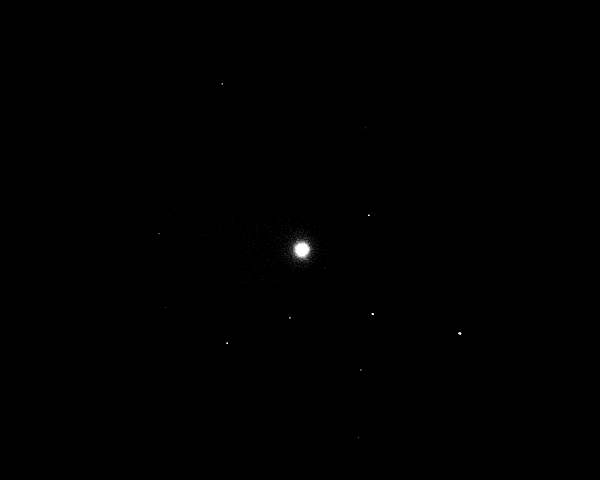iPhone Astrophotography Asteroid Vesta
Posted: 6 March 2021
Wednesday, 3 March 2021, was cloudy with strong wind starting in the afternoon. Thursday, 4 March, dawned clear and calm, but the sky began getting cloudy mid-morning and the wind returned. The wind calmed down by sunset but the cloudy sky remained. Friday, 5 March, dawned clear but windy. The wind began dying down mid-afternoon.
|
Open: Friday, 5 March 2021, 1815 MST Temperature: 79°F |
Session: 1607 Conditions: Clear |
Equipment:
12" f/8 LX600 w/StarLock
2" 24mm UWA eyepiece
2" 50mm eyepiece
1.25" 26mm eyepiece
Camera:
iPhone 11 Pro Max
1825 MST: sunset.
1826-1910 MST: relaxed on the observatory patio bench. It is always enjoyable to relax and watch the stars come out.
1912 MST: LX600 ON, StarLock OFF, High Precision OFF.
Viewed M42 (Orion Nebula), 102X and 49X.
Attached the iPhone 11 Pro Max to the 2" 50mm eyepiece using the Levenhuk adapter.
1934 MST: StarLock ON.
Took this StarLock autoguided afocal 49X image of M42 (the Great Orion Nebula) using the iPhone iOS Camera app (Night Mode, 30 seconds, 1X lens).

1938 MST: StarLock OFF.
1940 MST: the Zodiacal Light was easily seen in the western sky.
Viewed M42 (Orion Nebula), 94X.
1954 MST: viewed Asteroid Vesta using the Vortex 12x50 binoculars. Easy sight.
1958 MST: viewed Vesta, 94X. Locked 12" primary mirror.
I then began waiting for Vesta to rise a little higher in the eastern sky.
2000 MST: breezes began.
2008 MST: Stella Wi-Fi ON.
Used SkySafari 6 Pro on the iPhone to GOTO Vesta to confirm that the object I had in the eyepiece was in fact the asteroid Vesta. It was confirmed.
2010 MST: Wi-Fi OFF.
Attached the iPhone to the 1.25" 26mm eyepiece using the Meade adapter.
2023 MST: StarLock ON.
2030-2130 MST: imaged Vesta using the iOS app NightCap Camera (Long Exposure, Light Boost, ISO 12500, 1sec, 1 minute, 1X lens). As there were not very many bright stars in the eyepiece field-of-view it was necessary to overexpose Vesta in order to show some stars in the images. I took an image every 30 minutes.
2035 MST: saw Vesta with the naked eye. It was Mag. +6.2.
As I was imaging Vesta the breezes were getting stronger.
2115 MST: it was now very windy. The StarLock would frequently lose its lock on a guide star. My third image of Vesta was no good due to the strong wind moving the telescope during the exposure.
2131 MST: StarLock OFF.
Here is Vesta. The animated image shows the movement of Vesta over 30 minutes (2030 MST and 2100 MST). A satellite crossed the field-of-view at 2100 MST.


After removing the iPhone I viewed Vesta, 102X.
2136 MST: LX600 OFF.
2145 MST: took a SQM reading. Reported the result to Globe at Night.
|
Close: Friday, 5 March 2021, 2151 MST Temperature: 59°F |
Session Length: 3h 36m Conditions: Clear, windy, SQM 21.10 |
In October 2020 I did some White Balance color tests during two sessions at Cassiopeia Observatory. I have combined the reports into a single Sky and DSO White Balance Tests article.
Comments are welcome using Email. Twitter users can use the button below to tweet this report to their followers. Thanks.
Cassiopeia Observatory Home Page
Copyright ©2021 Michael L. Weasner / mweasner@me.com
URL = http://www.weasner.com/co/Reports/2021/03/06/index.html
